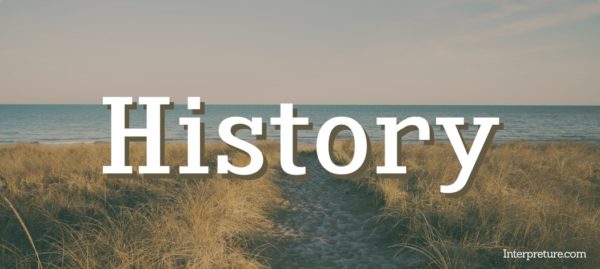‘History’ by John Burnside is a striking poem which considers the significance of historical events, particularly the World Trade Center attacks in September 2001. Burnside is a Scottish poet, born in 1955 in Fife. His motivation for writing is the “rhythm of the world” around him, which he sees as the essence of writing and the world around him. From this inspiration, he will build the poem in his head until it is at a state in which it can be written down. He has likened this process to metalwork, where while the lines are in his head they are “malleable” and can be changed, but once they are written down they aren’t changed much after this point.
This poem is part of the set of prescribed poems that could be included in the Edexcel English Literature exam, meaning that it is important to study, understand and revise this poem. Click here to see all the prescribed poems from the ‘Poems of the Decade’ collection.

Interpreture gives ‘History’ a difficulty rating of 4, meaning that it is deemed to be a relatively difficult poem. The meaning and themes become clearer throughout the poem, although some of the more advance ideas are slightly more difficult to understand. However the language and structure are both quite challenging, with the structure in particular something which could prove difficult for students due to it being highly irregular and unlike the majority of the poems in the ‘Poems of the Decade’ collection.
‘History’
The title is an ordinary word, and as such is open to a variety of interpretation, failing to give much indication of the meaning behind the poem. It indicates that it could be about a large-scale event, but this contrasts with the opening stanza beginning with “Today”, which may be confusing for a reader. However, the subtitle under the poem states “September 2001” which due to the significance associated with this time, it would immediately be clear that it is likely about the September 11 terrorist attacks, and Burnside will be reflecting historical significance of that day. This unlocks the initial overarching meaning of the poem, however it is important to note that there a range of deeper ideas that can still be interpreted from the rest of the poem.

Poem Structure
There is a highly irregular structure throughout the poem, with the free verse being used to its full effect with no particular consistency in stanza or line length whatsoever. This is very effective because it helps to convey the confusion and strong changes in emotions that could be felt by someone hearing the news, with their thought process becoming erratic as they attempt to process the information. Alternatively it could also be interpreted as being a visual representation of the destroyed and damaged twin towers, or as a broader representation of confusion and shock within society.
There are occasional stanzas which seem more deliberate and structured, showing small sections of collected thoughts and helping to convey important meanings and points from the poem, such as the links people share in society described in the line beginning “At times I think”. Despite this, the poem still feels dominated by vague ideas which show the confusion and uncertainty felt by the narrator. The mix of condensed and fragmented stanzas could be interpreted as showing the way in which different elements and parts of society could be seen to have disintegrated and been damaged over time, as a result of the gradual loss of collective memory of important past events.
Loss and confusion is further emphasised by the unfinished feeling that many lines have as a result of enjambment, with multiple lines flowing over each other. This helps to encourage a strong feeling of uncertainty because a reader is never sure as to when a line will end or pause, which would also likely extend to the rhythm of their speech when the poem is read aloud. This could also help with slowing the poem, allowing more time for a reader or audience to fully consider the significance of the descriptions.
Poetic Techniques
There is a semantic field of the sea in the poem, with various references to creatures including “jellyfish” and “carp”, and also the scenery of the beach and sea, such as “dune slacks” and “tideworn stone”. The references to such a variety of animals could be seen as representing the diversity of human life, demonstrating how despite everyone being different there are still factors that hold them in common, therefore creating a shared bond. This would be very effective for a reader because they would likely recognise how easy it is for division to arise from any sad or horrific event, so this allusion to unity would show how important Burnside believes it is.
Links to universal ideas that are rooted in the natural world is also a key part of ‘History’ with descriptions such as “tethers us to gravity and light” midway through the poem. The use of these fundamental ideas is designed to further highlight the shared experiences of humanity within the world, while the reference to “light” is used to bring a more positive and hopeful tone through its connotations. This positive light imagery also is part of a semantic field, with other references such as “gold” and “bright” helping to reinforce these positive elements further.
However, while there is positive imagery, this is against a backdrop of more uncertain and war related ideas that persist through the poem to ensure that there is still a general sense of unease felt by a reader. This is most notable at the beginning of the poem with reference to “war planes” which encourages a reader to consider the global and military repercussions, but also smaller references such as “petrol” and “states” which while are not directly about military or conflict, some readers may link them given the context; this would be very effective because it can be seen as representing the permanence of forms of conflict in the world.
Important Lines
“sand spinning off in ribbons”
This pleasant imagery acts as a contrast to the negative thoughts and ideas that continue throughout the rest of the poem, although arguably this phrase gives a hint of the future negative subject matter through the use of sibilance. In addition, the “spinning off” could be representative of either the destruction of the towers, or metaphorically representing the potential society as a whole now has to lurch to negative actions and to ‘spin out of control’.
“the muffled dread of what may come”
The highly emotive “dread” shows the emotion of the situation for the narrator, but coupled with “muffled” makes it sound more sinister and intimidating, with a lack of free expression. To some readers this could be particularly fearsome because it indicates a level of distortion, and therefore lack of clarity which further emphasises the confusing experiences.
“attentive to the irredeemable”
The whole phrase comes across as relatively repetitive due to the multiple syllables in “attentive” and “irredeemable” and consonance of the ‘t’ and ‘d’ sounds. This could be interpreted as demonstrating society’s focus on key news events and the way that more focus is typically given to the more horrendous acts and events. Ending the poem on this note almost acts as a warning or message to the reader about the way society can become enthralled with analysis of events such as these.
‘History’ Key Themes
- Society and Culture: ‘History’ directly addresses ideas regarding society and the reaction of society to terrorist attacks and traumatic events as a whole. This is both in the form of societal identity, and through the way in which society reacts.
- Identity: The poem looks at the idea of identity, using ideas of fish and sea life to represent the contrast and diversity in society while simultaneously showing what is held in common and shared between people.
- Conflict: While other poems in the anthology may consider conflict more directly, ‘History’ instead shows the repercussions of conflict and how these can impact on individuals and society as a whole. This arguably is more effective because it is more likely to be something that a reader can relate to.
Quick Focus Questions
- In what ways could ‘History’ be seen as exploring spiritual/philosophical ideas and themes?
- What may influence a reader to interpret the poem as sharing a degree of hope?
- The sea life described in the poem are often contained in bags or jars. How could this be significant?
Initially the structure of ‘History’ may make the poem feel daunting, however there is such a wide range of ideas that can come from this structure in addition to the interesting language and themes that it should result in a very interesting comparative essay. Imagery of the sea and considerations of society can be compared with ‘Look We Have Coming to Dover!’ while the structure could be contrasted with other poems such as ‘An Easy Passage’ or ‘Ode on a Grayson Perry Urn’. For unseen poetry, the way in which social comments are communicated would be an interesting potential comparison.







9 Comments
hi – which poem would you use to compare history with on theme of effects of conflict? i am thinking maybe chainsaw vs the pampas grass or lammas hireling but i don’t have any strong links
My initial thought would be ‘Giuseppe’ as this poem is set in Sicily in World War Two, and specifically looks at how the starvation as a consequence of war has resulted in transgressions. You could make comparisons to ‘History’ by looking at how the events are recounted and the different perspective (a first-hand experience is being described in ‘Giuseppe’ whereas ‘History’ is more abstract), plus of course the use of language and structure etc.
‘Chainsaw Versus the Pampas Grass’ would also be really interesting too as you would be able to consider the idea of conflict between nature and humanity, particularly the idea of recurring cycles. This is perhaps a bit more challenging to compare but there’s lots of really interesting language in the poem so that could be a good starting point.
What would you say about the repetition of “Today” ? What effect does it have on the reader?
I think “Today” is potentially one of the most important and interesting words in the poem. One interpretation could be that it helps emphasise that “History” is being created “today” as the poem is written, helping a reader to acknowledge the significance of events – and that what could have been an ordinary day like any other, has instead become extremely significant. This could encourage a reader to think about their own personal experiences of historic events, in turn helping them to empathise with the feelings of the narrator. This may be particularly useful and effective for young people who don’t have any memories of 9/11.
Thanks for the analysis – I initially found the perspective of the poem hard to understand and decipher as the events in the poem felt too detached from 9/11. However, I particularly enjoyed your points on the semantic field of the sea as a ‘mirror’ comparison to modern society and the human world on land, whilst universal experiences also help build a sense of collective identity.
Just a couple ideas of my own for anyone stumbling across: The poem mentions how “we trade so much to know the virtual we scarcely register the drift and tug of other bodies”. In this case, I think this poem could also be criticizing humanity’s increased dependence and attraction to materialism, which is highlighted by the contrast of the ‘virtual’ world to the semantic field of the ‘underwater world’. The description of a child’s actions in the poem could also be commenting on the need for a more natural and basic simple-mindedness which is less concerned with materialism.
Finally, in the last stanzas it mentions ‘a kite plugged into the sky’, which is an allusion to Benjamin Franklin’s open-minded act of using a kite in a storm to prove his theory on electric charge. This could show how we should not respond to 9/11 and other catastrophic events with anger, but rather with moral virtue, tolerance, and an open-minded mindset.
Hope these ideas add on to the analysis already present!
These are really interesting interpretations, thanks for sharing!
whats the answer for Q3
I was wondering if anyone could further explain the effect of ending the poem on the word “irredeemable”?
hello, which poem would you choose to compare History on the theme of ‘sense of danger’, something does tell me it could be Look We Have Coming To Dover but it doesn’t have such strong links